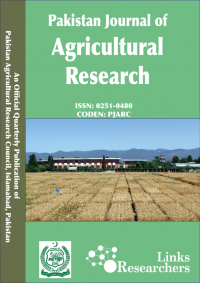Sidra Majeed, Shahid Ahmad*, Asif Ali Bhatti** and Ghazanfar Abbas***
ABSTRACT
Organic wheat production was initiated at the National Agricultural Research Centre (NARC) during 1998-1999. Data of wheat grown using chemical fertilizers for the same period were obtained for wheat productivity from the Farm Operations and Services (FOS) crop registers. Water productivity of barani organic desi wheat (C591) grown at NARC was computed using the data of last 10 years (1998-08), which revealed variation from 1.98 to 0.29 kgm-3 of seasonal rainfall. The correlation between seasonal rainfall and water productivity is very high (0.93). There is a strong correlation between seasonal rainfall and yield of barani wheat. The yield of barani wheat grown using chemical fertilizers varied from 0.41 to 3.21 t ha-1 represents an eight-fold variation in the wheat yield of last 10 years (1998-08). There were almost three years when the yield was higher than the mean yield and three years when yield was lower than the mean yield by around 1.0 t ha- 1. Economic analysis revealed that the average net return was Rs. 6744 ha-1 with minimum loss of Rs. 7674 ha-1 during 2000-01 to a gain of Rs. 20822 ha-1 during 2004-05. The analysis of cost of production indicated that the increase was largely in the cost of tillage and harvesting due to increase in the price of diesel fuel and renting cost of farm machinery. The average net return from barani wheat using chemical fertilizer is Rs. 1.22 million, on an average the benefit and cost ratio was 1.28, which means that 28 % of the total cost is realized back in the form of net returns. Out of ten years, the barani wheat production using chemical fertilizer was profitable in six years.
To share on other social networks, click on any share button. What are these?







